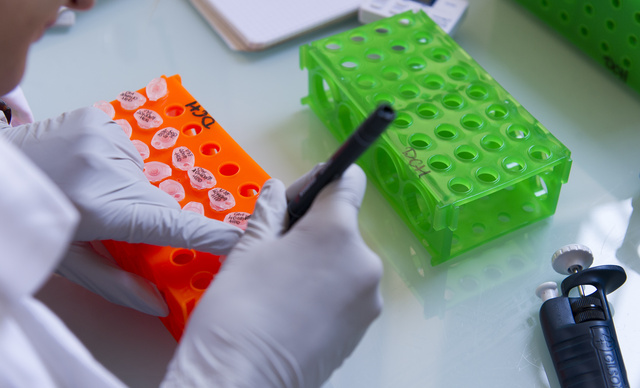Centromeres, centrosomes and cell division
Often at the origin of a cancer, is cell division that has gone wrong. It is not surprising therefore that a PIC3i research programme, self-financed in large part by public generosity, has brought together the expertise of young biologists and chemists to understand this major step in the life of the cell.

Cell division is at the heart of much research. At Institut Curie, several teams are exploring this key stage leading to the formation of new cells. For Renata Basto, CNRS director of research, the centrosome is the star: this minuscule component organises the microtubules - rails on which chromosomes move to separate during cell division. Daniele Fachinetti, who has just joined Institut Curie, is ore specifically interested in the heart of the chromosome, the centromere. This anchor point serves to guide the chromosomes during cell division. Geneviève Almouzni's team is studying how the centromere forms and maintains over several divisions.
"The idea we had was to combine our strengths to study the previously unexplored links that may exist between the centrosome and the centromere during cell division", explains Renata Basto, head of the Biology of the centrosome and cilium team (CNRS/Institut Curie) who is coordinating this project. We also called on the chemist, Raphaël Rodriguez. His mission will be to "screen" a whole set of molecules to try to restore them.
When the centromeres or centrosomes malfunction, the balanced separation of chromosomes between the two daughter cells goes wrong. The cell may then decide to interrupt division to attempt a "repair", or self destruct. "While we know that the P53 protein plays a major role in stopping this division, we still know little about the detail of the molecular mechanisms that bring it into play", adds Renata Basto. "So we will be looking into the set of reactions between when the disturbances occur in the centrosomes or centromeres and cell division is stopped by P53." To shed light on the mechanisms prior to activation of P53, researchers at Institut Curie have called on an internationally renowned specialist in this protein: Laure Attardi from Stanford University (California, United States).
With this PIC3i, researchers hope to better understand the deregulations observed in faulty cells: when and how does a cell decide to self-destruct? How can the cell division cycle be blocked? Who are the key players in this mechanism? The answers to these questions will provide new perspectives in understanding carcinogenesis and avenues for "blocking" tumour cells.
Coordinator
- Renata Basto, head of the Biology of the centrosome and cilium team (CNRS/Institut Curie)
Partenaires
- Daniele Fachinetti, head of Molecular Mechanisms of Chromosome Dynamics team (CNRS/Institut Curie)
- Raphaël Rodriguez, head of Chemical Cell Biology team (CNRS/Inserm/Institut Curie)
- Geneviève Almouzni, head of Chromatin dynamics team (CNRS/Institut Curie)
- Laura Attardi, Department of Radiation and Cancer Biology, Stanford University, USA
